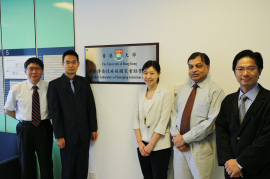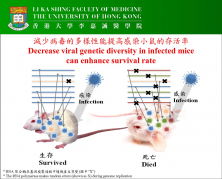Media
HKU and international research teams provided direct experimental evidence for the role of genetic diversity in influenza virulence in vivo
03 Sep 2014
An international research team, led by Dr Yen Hui-ling, Assistant Professor of School of Public Health and Professor Malik Peiris, Tam Wah-Ching Professor in Medical Science, Chair Professor of Virology and Director of School of Public Health, Li Ka Shing Faculty of Medicine, The University of Hong Kong (HKU), in collaboration with the Wellcome Trust Sanger Institute (UK), have generated and characterised influenza A viruses with identical consensus genetic sequence but differing in the extent of genetic diversity within each virus population. They demonstrate that reduction in genetic diversity is associated with a reduction in virus virulence i.e. severity of disease in mice. The research has been published today in the prestigious international scientific journal, Nature Communications.
Research Implications
Dr Yen Hui-ling Yen, Assistant Professor of School of Public Health, Li Ka Shing Faculty of Medicine, HKU says, “Influenza virus relies on its own enzymes (RNA polymerase) to copy its genetic information during multiplication. The RNA polymerase is error-prone and makes random errors (mutations) during genome replication. The outcome is the generation of a ‘swarm’ of virus mutants with minor genetic differences from each other. This genetic diversity facilitates influenza virus survival under different selection pressures. We generated influenza A viruses with increased RNA polymerase fidelity which allow us to study the role of genetic diversity experimentally”.
Professor Malik Peiris, Tam Wah-Ching Professor in Medical Science, Chair Professor of Virology and Director of School of Public Health, Li Ka Shing Faculty of Medicine, HKU says, “This work leads to a different understanding of the mechanisms of virus virulence. A single mutation in one of the influenza polymerase genes (PB1) can lead to decreased genetic diversity and populations of such viruses have reduced disease severity even though they appear genetically identical in all other respects when using conventional genetic sequencing methods. This was true for both seasonal influenza and highly pathogenic H5N1 influenza virus. This information provides a target for future development of antiviral drugs and an approach to improve live attenuated influenza vaccines”.
Study method and findings
The research team generated the high fidelity influenza virus by passaging a human seasonal H3N2 influenza virus in the presence of ribavirin, a nucleoside analog that possess mutagen effect by increasing the error rate of influenza viral RNA polymerase. A single PB1-V43I mutation was identified to increase viral RNA polymerase fidelity in both seasonal H3N2 and highly pathogenic H5N1 influenza viruses. The H5N1 virus with increased RNA polymerase fidelity multiplied efficiently in the mouse lungs. However, a decreased viral genetic diversity was noted and the mortality rate of mice infected by this mutant was found to be 10 times less than the control. The study provided direct experimental evidence to demonstrate the role of viral genetic diversity in influenza virulence.
Background
Influenza virus, similar to other RNA viruses, relies on its own viral RNA polymerase to replicate its genetic materials during infection. The viral polymerase is error-prone and makes random mutations during genome transcription. This would lead to the generation of a progeny viral population with minor genetic differences from each other. This genetic diversity is also termed “quasispecies” and it is believed to be an important strategy for RNA viruses to survive under selection pressures, such as host immune responses. However, it has been challenging to provide experimental proof for the role of “quasispecies” in RNA virus survival. This concept was first experimentally demonstrated using poliovirus but has not been studied for influenza virus to date.
About the research team
This research was carried out by Dr Peter Cheung Pak-hang, Research Associate, as his PhD research study under the supervisions of Dr Yen Hui-ling, Assistant Professor at the School of Public Health and Professor Malik Peiris, Tam Wah-Ching Professor in Medical Science and Chair Professor of Virology and Director of School of Public Health, Li Ka Shing Faculty of Medicine, HKU. Major team members from the School of Public Health in this study include Dr Leo Poon, Associate Professor and Professor Yi Guan, Daniel CK Yu Professor in Virology at the School of Public Health, Li Ka Shing Faculty of Medicine, HKU. The study was in collaboration with Dr Paul Kellam at the Wellcome Trust Sanger Institute, UK.
This study was supported by the Area of Excellence Scheme of the University Grants Committee (grant AoE/M-12/06) and the National Institutes of Health (NIAID contract HHSN272201400006C).
Please visit the website at http://www.med.hku.hk/v1/news-and-events/press-releases/ for press photos.
Group photo of the research team at the School of Public Health, Li Ka Shing Faculty of Medicine, The University of Hong Kong. (From Left to Right) Professor Yi Guan, Daniel CK Yu Professor in Virology; Dr Peter Cheung Pak-hang, Research Associate; Dr Yen Hui-ling, Assistant Professor; Professor Malik Peiris, Tam Wah-Ching Professor in Medical Science, Chair Professor of Virology & Director of School of Public Health and Dr Leo Poon, Associate Professor.


